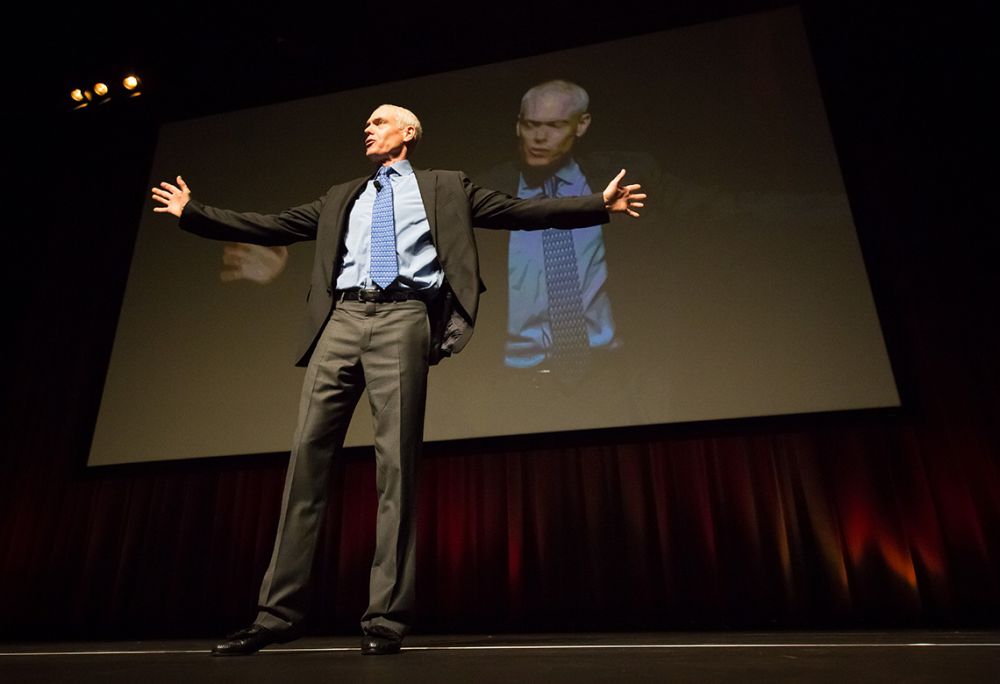How to be optimistic when extreme bad luck (inevitably) hits

“We believe there will be no ‘new normal’. There will only be a continuous series of ‘not normal’ times.”
- 2011 quote from Great by Choice.
Great by Choice is THE essential read for leaders in times like this.
Jim Collins (Good to Great, Built to Last) and Morten Hansen (Great at Work) spent 9 years researching companies that thrived during global disruptive, chaotic, and extreme events.
As we count down to Jim Collins - Roadmap to Greatness an exclusive solo event presented by The Growth Faculty, here are two short summaries of this timeless and uplifting book.
Great by Choice 1 minute summary:
"Uncertainty is permanent, chaotic times are normal, change is accelerating, and instability will likely characterise the rest of our lives."
Extreme, unstable forces by themselves do not undo a great company.
But undisciplined behaviour does, finds 7 years of research by Jim Collins and Morten Hansen.
Discipline matters.
- Great companies never relax when blessed with good luck;
- They never wallow in despair when hit with bad luck.
- They keep pushing for the overall goal and cause.
10X companies (those that perform at more than 10X their industry average) always have these behaviours:
- Fanatic discipline We're talking off the chart discipline.
- Empirical creativity Evidence from hard data before action.
- Productive paranoia Their catch cry is “What if? What if? What if?”
- Level 5 ambition. They channel all their energy to the cause (not their ego).
Techniques they use:
- 20 Mile March - They hit specified performance markers with great consistency over a long period of time.
- Fire Bullets, then Cannonballs - They fire bullets at new products, services, technologies - and cannonballs only after a bullet hits a target.
- Leading Above the Death Line - They have cash for bad times, avoid risks that could kill them, and are on the lookout for trouble at all times.
- SMaC (Specific, Methodical, and Consistent) - They stick to the recipe that works for their organisation.
Great by Choice 3 minute summary:
“Life offers no guarantees…. The next Great Disruption will come, and the next one after that, and the next one after that, forever.”
Chapter One: Thriving in uncertainty
Two pairs of 7 companies were studied by Jim Collins and Morten Hansen during a 7 year period of extreme events (eg. recessions, war, 9/11).
One thrived (10X the industry average performance). One languished.
Despite patches of terrible business conditions, the 10X companies were so successful, you'd have banked up to $US12 million if you'd invested $US10,000 in any one of them over the study period (1972 to 2002).
The pairs studied were:
- Amgen vs Genetech;
- Biomet vs Kirschner;
- Intel vs AMD;
- Microsoft vs Apple (focusing on the 80s and 90s);
- Progressive vs Safeco;
- Southwest Airlines to PSA;
- Stryker vs United States Surgical Corporation (USSC).
Chapter 2: 10Xers
The company pairs had divergent outcomes because of different behaviours.
The 10Xers exhibited 4 key behaviours:
- Fanatic discipline. 10Xers aren’t just disciplined, they are fanatics. Their behaviour fits nowhere on a normal curve.
- Empirical creativity. They look primarily to empirical evidence, rather than other people or conventional wisdom, before they act.
- Productive paranoia. They consider failure on a regular basis, maintaining hypervigilance in good times as well as bad. They’re always asking “What if? What if? What if?”
- Level 5 ambition. 10Xers channel their energy into something larger and more enduring than themselves.

(Image: 10Xer diagram of behaviours)
Chapter 3: 20 Mile March
“The more turbulent the world, the more you need to be a '20 Mile Marcher’.”
This was a distinguishing factor, to an overwhelming degree, between the 10X companies and the comparisons.
The first man to reach the South Pole, Norwegian Roald Amundsen, marched about 20 miles on calm days, and about 20 miles in screeching gales.
He was consistent. He didn’t march 40 miles on good days, nor zero on bad days.
Like Amundsen, 10Xer companies consistently achieved their own version of the 20 Mile March.
10Xers make incremental progress year after year by consistently hitting specified performance markers.
- They have unwavering commitment to high performance in difficult conditions
- They hold back in good conditions
Chapter 4: Fire Bullets, then Cannonballs
“A method for making progress rather than getting paralysed, frozen by life’s uncertainties.”
Instead of big leap innovations, 10X companies “fire bullets, then cannonballs” to try out new products, technologies, services, or processes.
Instead of trying to predict the future, 10Xers ask:
- How can we fire a bullet on this?
- What bullets have others fired?
- What does this bullet teach us?
- Do we have enough empirical validation to fire a cannonball?
10X winners were found to have innovated less than the authors expected (relative to their industries and their comparison cases).
"They were innovative enough to be successful, but generally not the most innovative,” they write.
Chapter 5: Leading Above the Death Line
“The only mistakes you can learn from are the ones you survive.”
10X winners always assume that conditions can change, violently and fast.
So, they exhibit 3 types of productive paranoia:
1. Extra oxygen cannisters (big margins of safety in cash reserves)
2. Bounding risk
- They avoid “Death Line risk” that could kill or severely damage the enterprise.
- They shun “Asymmetric risk” (those risks for which the potential downside is much bigger than the potential upside).
- They steer away from “Uncontrollable risk” that exposes the enterprise to events they can't control.
3. Zoom out, then zoom in
- 10X leaders obsessively focus on their objectives, and are hypervigilant about changes in their environment.
Chapter 6: SMaC (Specific, Methodical, and Consistent)
“The more unforgiving your world, the more SMaC you need to be.”
SMaC is a recipe that forces order amidst chaos.
You set out the dos and don’ts (specific operating practices) that work, and you adhere to them.
For example, in the study period, Southwest Airlines's SMaC recipe included:
- The passenger is our #1 product. Do not carry air freight or mail, only small packages which have high profitability and low handing costs;
- Stay out of food services;
- Utilise the 737 as our primary aircraft for 10 to 12 years;
- Remain a short haul carrier, under two-hour segments.
Chapter 7: Return on luck
“The environment doesn’t determine why some companies thrive in chaos and why others don’t. People do.”
Who luck (the luck of finding the right mentor, partner, teammate, leader, friend) is one of the most important types of luck, say Collins and Hansen.
The real difference between the 10X and comparison cases was ROL (Return on Luck).
- They zoomed out to recognise when a luck event had happened and to consider whether they should let it disrupt their plans.
- If yes, they threw themselves at the luck event with ferocious intensity, not letting up.
Summary
Collins and Hansen ended their 9 year study more optimistic and hopeful than before.
"More than any of our prior research," they write in Great by Choice, "this study shows that whether we prevail or fail, endure or die, depends more upon what we do than on what the world does to us. We take particular solace from the fact that every 10Xer made mistakes, even some very big mistakes, yet was able to self-correct, survive, and build greatness."
If you'd like to increase your professional development why not consider becoming a member of The Growth Faculty? One membership, unlimited access to 30 live virtual Time For Transformation masterclasses and the best live virtual events - PLUS year-round leadership content On Demand with videos, podcasts and book summaries. Join a community of knowledge seekers who are inspired by the best. Access $4350+ value for just $398 AUD. See who's up next.


 Australia
Australia
 European Union
European Union
 New Zealand
New Zealand
 United Kingdom
United Kingdom
 United States
United States
 Singapore
Singapore

